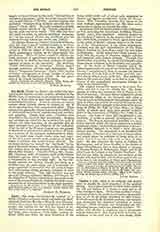

Juste. —The name conventionally applied to a family of Italian sculptors, whose real names was Betti, originally from San Martino a Mensola, near Florence. Guisto, whose name was afterwards given the whole family, and Andrea are the first known to us. Neither seems to have gone out of Italy. But Andrea had three sons—Anthony (1479-1519), Andrew (b. about 1483), and John, the most illustrious of the house (1485-1549)—all of whom early emigrated to France and figured prominently during the Renaissance. With Francesco Laurana they stand as the most brilliant representatives and the most active emissaries of Italian art beyond the Alps.
As early as 1504 the three brothers were in Brittany, at Dol, executing the monument of Bishop Thomas James. Later, they separated. Anthony worked for the Cardinal d’Amboise in the famous castle of Gaillon; while John, attracted to Tours, spent a few years in the atelier of Michel Colombe, famous as the sculptor of the “Entombment” in the Abbey of Solesmes. Colombe was the last representative of the Dijon School, founded by Claus Sluter under the first dukes of Burgundy. At his school John Juste became imbued with the realism of Flanders, slightly softened and tempered with French delicacy. Through this combination of qualities, he created for himself a style whose charm consisted in its flexibility and complexity. At the death of Michel Colombe (1512) the Justes worked again in concert and inherited his fame. Francis I commissioned them to execute the famous mausoleum of Louis XII at St-Denis, and this occupied almost fifteen years (1516-31). But Anthony’s share in this work was slight, as he died in 1519. The honor of this magnificent masterpiece belongs entirely to his brother John.
The original conception seems to have been Perréal’s, and yet it was not wholly his. The iconography of tombs was extremely rich in France in the fifteenth century. Its main theme consists of a gisant or recumbent effigy of the deceased, laid upon a funeral couch surmounting the sarcophagus, upon the sides of which a procession of mourners is represented. The most celebrated example of this style is the monument of Philip the Bold by Claus Sluter, at Dijon (1405), of which there have been several variants, down to the monument of Philippe Pot (1480) in the Louvre. The tomb of Louis XII inaugurated a new tradition, or rather a colossal development of the subject. The hero is represented kneeling on a catafalque beneath which the gisant appears as a naked, emaciated corpse, “such as death has made it for us”. This striking contrast is in itself a most eloquent funeral oration. The monument is an incomparable masterpiece; it has served as the type of many others, and would, alone, be sufficient to bring glory to an artist; but it is not the only work we have of John Juste. He also executed the tombs of Philippe de Montmorency and of Artus Gouffier in the church of Oiron (Deux-Sèvres), that of Jean Rieux, at Ancenis, of Thomas Bohier, at St-Saturnin, Tours, and of the Abbé Louis de Crévent at the Trinité, Vendôme. He had one son, John the second, the last sculptor of the family, who died in 1577, and of whom some works are to be seen in the churches of Oiron and Champeaux.
LOUIS GILLET

